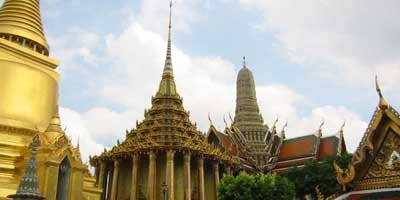Definition
A wat (derived from the Pali word avasa as well as from the Sanskrit word avasatha) is a monastery temple in Cambodia, Laos or Thailand. The word "wat" (Thai วัด) (sometimes rendered "vat" when referring to Laos) means "school." Strictly speaking a wat is a Buddhist temple and school with resident monks. A Buddhist site without resident monks cannot correctly be described as a wat, although the term is frequently used more loosely, even for ruins of ancient temples.
In everyday language in Thailand a wat is any place of worship except a mosque. Thus wat cheen is a Chinese temple (either Buddhist or Taoist), wat khaek is a Hindu temple, and wat kris or wat krit or wat fa-hrang is a Christian church.
Structure
A typical Buddhist wat consists of the following buildings:
- chedi - (from Sanskrit: Chaitya - Temple) usually conical or bell-shaped buildings, often containing relics of Buddha;
- viharn or wihaan (from Sanskrit: vihara and Pali vihaan ) - a meeting and prayer room;
- mondop (from Sanskrit: Mandapa) - a usually open, square building with four arches and a pyramidal roof, used to worship religious texts or objects.
- sala (from Portuguese for "hall") - a pavilion for relaxation or miscellaneous activities; Could also be from Sanskrit: Shala - School)
- bot or ubosoth - the most holy prayer room, also called the "ordination hall" as it is where new monks take their vows. Architecturally it is similar to the vihara; the main differences are the eight cornerstones placed around the bot to ward off evil. The bot is usually more decorated than the viharn. (from Pali: Uposatha)
- haw trai - Tripitaka library where Buddhist scriptures are kept ;
- haw klawng - drum tower ;
- haw rakhang - bell tower.
The living quarters of the monks, including the kutis (monk cells) are separated from the sacred buildings.
